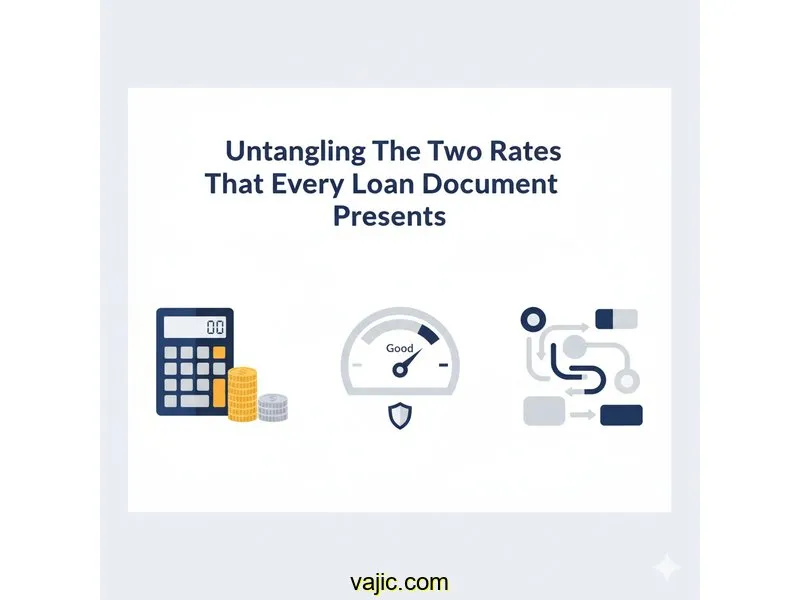
Auto Loan Calculator
Calculate payments over the life of your Loan
Home Blog Privacy Terms About Contact
Calculate payments over the life of your Loan
Home Blog Privacy Terms About ContactPublished on October 15, 2025

My journey into the weeds of financial math started with a single document. It was a sample loan quote I was looking at, purely for educational purposes, to understand how these things are structured. On it, I saw two percentages that seemed to be talking about the same thing, but with different numbers. One was labeled "Interest Rate: 6.3%" and right below it, another said "APR: 7.15%." I stared at them for a long time. My first thought was that it must be a typo. How could there be two different yearly rates for the same loan?
This simple discrepancy sparked a genuine curiosity. It wasn't about the loan itself, but about the math. What was the story behind these two numbers? Why wasn't the rate just the rate? I felt like I was missing a fundamental piece of the puzzle, and it bothered me. My goal became simple: I wanted to understand, on a mathematical level, how a 6.3% rate could magically become a 7.15% APR. I wanted to be able to explain it to myself, using a calculator, and see the numbers line up perfectly.
I opened up a standard online loan tool and started plugging in the numbers from the quote: a principal amount of $11,750 over a term of 60 months. When I entered the 6.3% interest rate, the tool gave me a monthly payment of $229.83, which matched the quote exactly. I felt a small victory, but it was short-lived. The real mystery remained unsolved. Where did that 7.15% come from? It wasn't an input field, and it wasn't an output I could see on this basic tool. I knew then that my understanding was only surface-deep.
This is the story of how I went down the rabbit hole to connect those two dots. It's a personal log of my learning process, a documentation of my confusion, and the eventual "aha!" moment that made it all click. Please remember, this is about understanding how calculations work, not financial advice. My aim is simply to share the steps of my own educational journey into the mechanics of loan math.
My initial confidence from matching the monthly payment quickly faded into frustration. I had three variables that seemed to work together perfectly: the principal of $11,750, the term of 60 months, and the rate of 6.3%. Together, they produced the monthly payment of $229.83. But the fourth variable, the 7.15% APR, felt like an outsider that didn't belong to the same family of numbers. It was a mathematical mystery I was determined to solve.
My first logical step was to reverse-engineer it. "Maybe," I thought, "the APR is the real rate?" I went back to the online tool, kept the $11,750 principal and 60-month term, but this time I typed 7.15% into the interest rate field. The tool crunched the numbers and presented a new monthly payment: $235.21. This was wrong. It didn't match the $229.83 on my sample document. Now I was even more confused. The 6.3% rate produced the correct payment, but the 7.15% APR was the officially stated "rate," yet it produced the wrong payment. It felt like a contradiction.
I spent a good hour trying different combinations. I wondered if the APR was calculated after the first year, or if it was an average. I tried to find a mathematical relationship between 6.3 and 7.15. Was one a percentage of the other? Did they get added together somehow? Every hypothesis I had led to a dead end. The numbers on my screen refused to reconcile, and I realized my fundamental understanding of the terms was flawed. I wasn't just doing the math wrong; I didn't even know what I was supposed to be calculating.
This was the critical point in my learning process. The frustration forced me to stop guessing and start investigating. The disconnect wasn't in the calculator; it was in my head. I had been treating "Interest Rate" and "APR" as synonyms, and the document in front of me was screaming that they were not. I knew there had to be another component, a missing piece of data that acted as the bridge between these two percentages. I just had no idea what it was.

My investigation began with a simple web search: "What is the difference between interest rate and APR?" The results were overwhelming at first, full of dense financial jargon. But as I sifted through the information, one word kept appearing over and over again: fees. That was it. That was the missing ingredient I had been looking for. The Annual Percentage Rate, I learned, wasn't just the interest. It was a standardized rate that incorporated the interest plus any upfront fees associated with the loan.
This revelation changed everything. I went back to the fine print of my sample document, and there it was, a line item I had completely ignored: a "$400 Origination Fee." Suddenly, the puzzle started to make sense. The loan was for $11,750, and the interest was calculated on that full amount. However, because of the fee, the actual amount of money being disbursed was effectively $11,350 ($11,750 - $400). I was making payments on a larger sum than what was actually provided. The APR, I realized, was a mechanism to show the true yearly percentage you're paying on the money you actually get to use. It was the great equalizer.
The discovery of the $400 origination fee was the breakthrough moment. It was the hidden variable that my simple calculators didn't account for. I learned that these fees, which can also be called processing fees or application fees, are considered "prepaid finance charges." They are part of the price of borrowing money, so they have to be included in the overall rate calculation to give a true picture.
With this new information, I could calculate the true finance charge. It wasn't just the total interest I would pay ($2,039.80 over 60 months). It was the interest plus the fee. So, the total price to borrow the money was actually $2,039.80 + $400 = $2,439.80. The APR's job is to take this total charge and express it as a yearly percentage rate based on the loan's terms.
Armed with this new knowledge, I searched for a more advanced "APR Calculator." These tools have extra fields for things like origination fees. I entered all the known variables: the loan amount of $11,750, the interest rate of 6.3%, the term of 60 months, and the upfront fee of $400. I held my breath and clicked "Calculate." The screen refreshed, and there it was: 7.15%. The numbers finally lined up. The mystery was solved, and I felt a profound sense of clarity. Every number on the document now had a logical place and purpose.
To be certain I truly understood, I created a second hypothetical scenario: an $18,200 loan at 5.8% for 48 months with a $550 fee. I first calculated the payment based on the rate, then added the fee to the total interest to find the full finance charge. Then, using the APR tool, I plugged in all the variables and it confirmed my manual check. I wasn't just following a formula anymore; I understood the story the numbers were telling.
This deep dive, which started with simple confusion, fundamentally shifted my understanding of how loan mechanics work. I moved from just looking at numbers to comprehending the narrative they tell. Here are the key lessons I took away from this process, focused purely on the math and the tools:
From my learning journey, the best way is to use a dedicated APR calculator. You'll need the principal loan amount, the interest rate, the loan term, and a list of all prepaid finance charges (like origination or processing fees). By plugging these numbers in, the calculator should produce an APR that matches what's on your document. If it doesn't, it's a good prompt to review the numbers and understand the discrepancy.
Think of it like this: the interest rate is the price of the product (the borrowed money). The APR is the price of the product *plus* the shipping and handling (the fees). It gives you a more complete "total price" expressed as a single yearly percentage.
Yes. This happens when a loan has zero prepaid finance charges. If there are no origination fees, application fees, or other upfront costs rolled into the loan, then the total finance charge is just the interest. In that specific case, the APR and the interest rate will be identical.
Understanding the interest rate helps you see how your monthly payment is calculated based on the principal balance. Understanding the APR gives you a tool to compare the complete price of different loan options. One tells you about the payment mechanics, while the other tells you about the overall price tag.
The journey from being confused by two percentages to understanding their intricate relationship was incredibly rewarding. My biggest takeaway wasn't about which loan was "better" or what decision to make. It was the realization that every number on a financial document has a purpose and a logical origin. The APR isn't a random, inflated number; it's a carefully constructed piece of information designed to provide clarity, even if it seems confusing at first.
It took some time and a bit of frustration, but methodically breaking down the problem, identifying the missing pieces (the fees!), and using the right tools to put it all back together transformed my understanding. Learning this piece of financial math wasn't about becoming an expert; it was about building confidence. It was about knowing that with a little curiosity and persistence, the numbers will eventually tell their story.
I hope sharing my personal learning process is helpful. If you've ever felt intimidated by financial jargon, my encouragement is to pick one small thing that confuses you and follow that thread. You might be surprised by the clarity you find at the end of it.
This article is about understanding calculations and using tools. For financial decisions, always consult a qualified financial professional.
Disclaimer: This article documents my personal journey learning about loan calculations and how to use financial calculators. This is educational content about understanding math and using tools—not financial advice. Actual loan terms, rates, and costs vary based on individual circumstances, creditworthiness, and lender policies. Calculator results are estimates for educational purposes. Always verify calculations with your lender and consult a qualified financial advisor before making any financial decisions.
